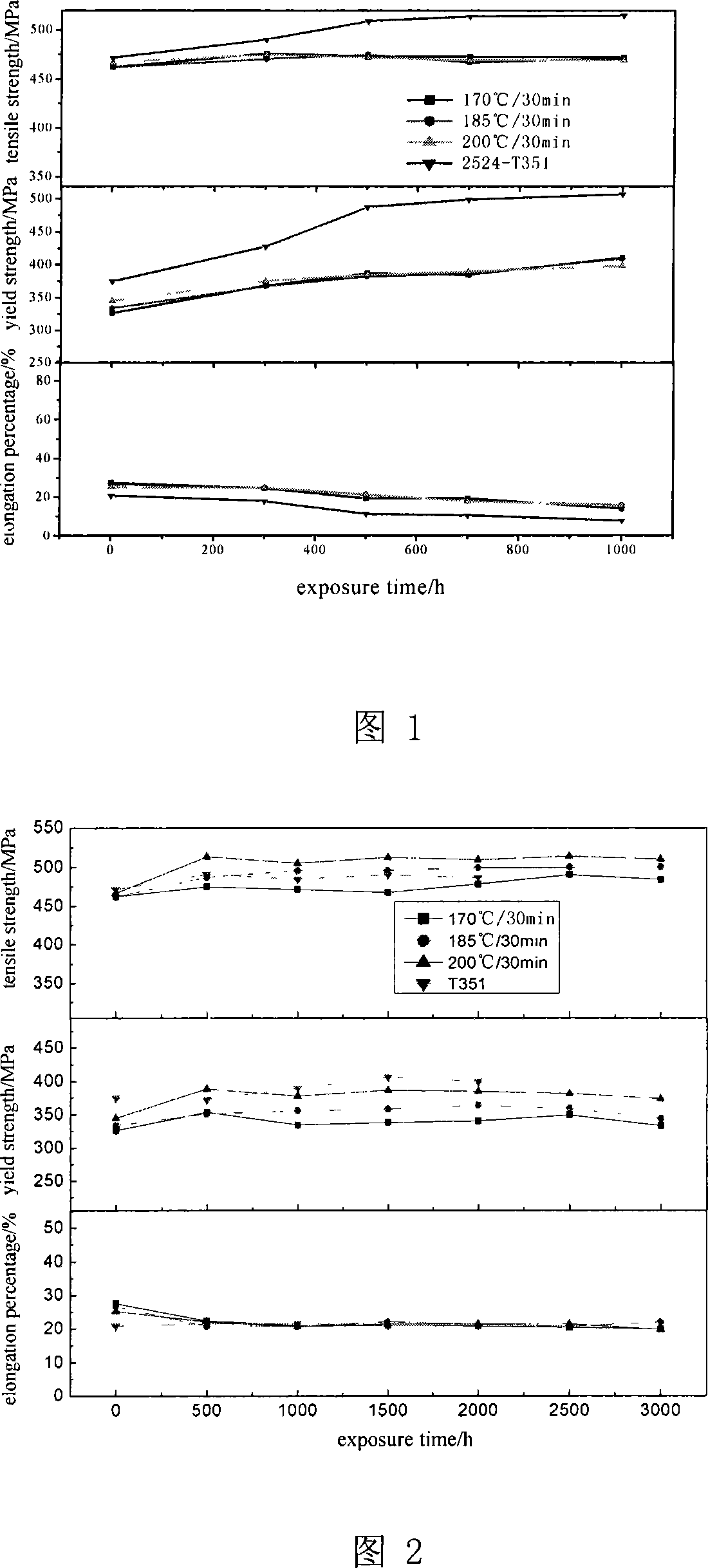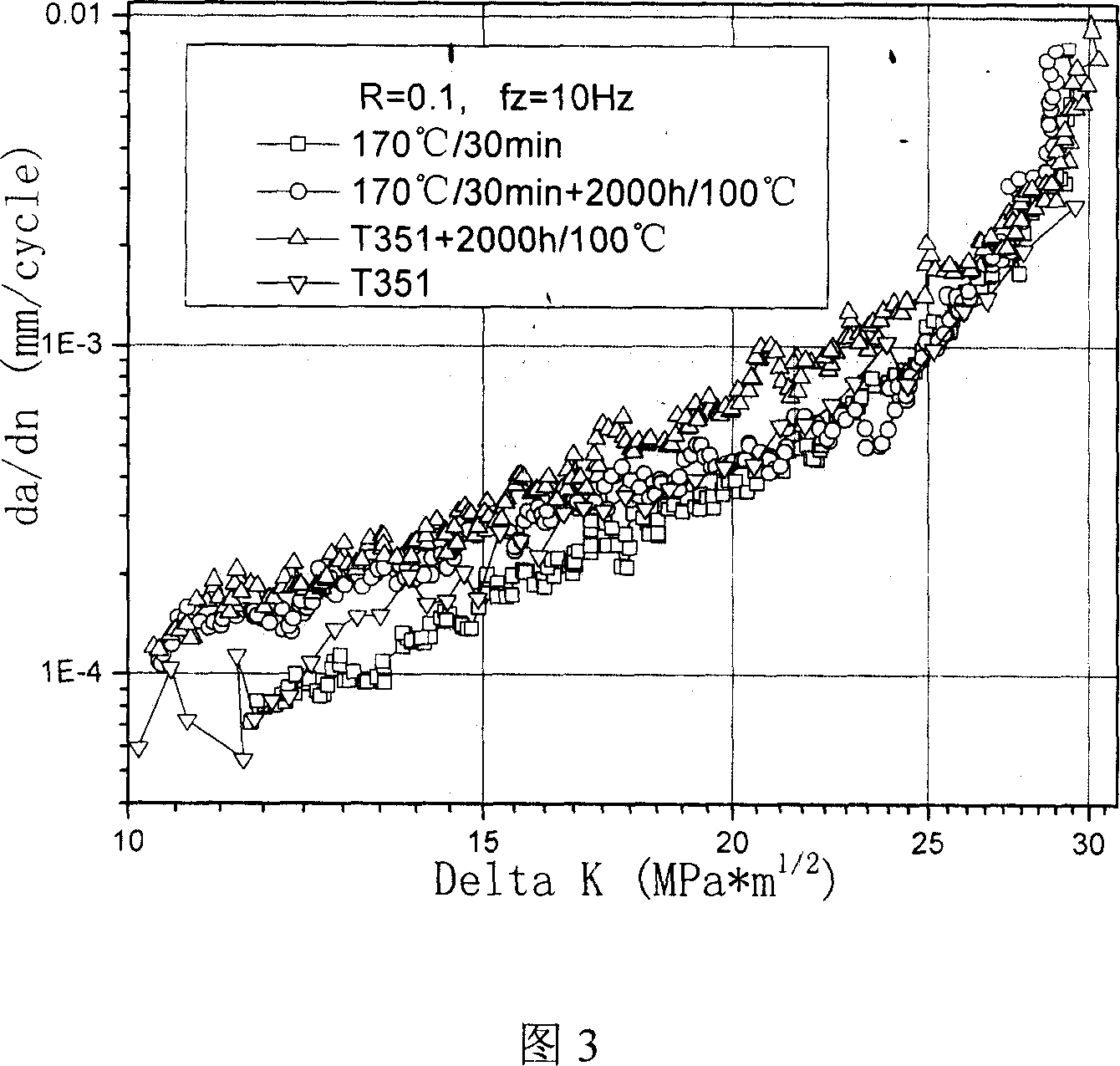Treatment method for providing aluminum alloy with high thermal stability anti-fatigue microstructure
A technology with high thermal stability and processing method, which is applied in the processing field of aluminum alloy to obtain high thermal stability, high strength and anti-fatigue microstructure, which can solve the problems of accelerated fatigue crack growth, difficult recovery movement of alloys, uniform deformation of fatigue crack tip, etc., to achieve Effects of delaying degradation and excellent fatigue resistance
- Summary
- Abstract
- Description
- Claims
- Application Information
AI Technical Summary
Problems solved by technology
Method used
Image
Examples
Embodiment 1
[0016] The alloy composition is: 4.0% Cu, 1.2% Mg, 0.6% Mn, 0.2% Ti, and the balance is Al 2524 aluminum alloy plate is solid-dissolved at 490°C for 1 hour and water quenched, and then aged at 170°C for 50 minutes. Mechanical properties at room temperature after this treatment: tensile strength is 462MPa, yield strength is 326MPa, elongation is 27%; after heat exposure at 135°C / 1000 hours, the tensile strength of the alloy is 472MPa, yield strength is 410MPa , the elongation is 14%; after 100°C / 2000 hours of heat exposure, the tensile strength of the alloy is 484MPa, the yield strength is 333MPa, and the elongation is 19%. The fatigue crack growth rate of the original state alloy by this treatment method is lower than that of the T351 state alloy; after heat exposure, the fatigue crack growth rate of the alloy treated by this treatment method is still lower than that of the T351 treated alloy after heat exposure.
Embodiment 2
[0018] The alloy composition is: 4.0% Cu, 1.2% Mg, 0.6% Mn, 0.2% Ti, and the balance is Al in solid solution for 1.5 hours at 500°C and water quenched, and then aged at 185°C for 30 minutes. Mechanical properties after this treatment: the tensile strength of the alloy at room temperature is 461MPa, the yield strength is 333MPa, and the elongation is 26.8%; after heat exposure at 135°C / 1000 hours, the tensile strength of the alloy at room temperature is 470.9MPa , the yield strength is 409MPa, and the elongation is 15.8%; after 100℃ / 2000 hours of heat exposure, the tensile strength of the alloy at room temperature is 484MPa, the yield strength is 333MPa, and the elongation is 22%. The fatigue crack growth rate of the original state alloy by this treatment method is lower than that of the T351 state alloy; after heat exposure, the fatigue crack growth rate of the alloy treated by this treatment method is still lower than that of the T351 treated alloy after heat exposure.
Embodiment 3
[0020] The alloy composition is: 4.0% Cu, 1.2% Mg, 0.6% Mn, 0.2% Ti, and the balance is Al. The aluminum alloy plate is solid-dissolved at 500°C for 1 hour and quenched in water, and then aged at 200°C for 30 minutes. The mechanical properties after this treatment: the tensile strength of the alloy at room temperature is 466MPa, the yield strength is 344MPa, and the elongation is 25.2%; after heat exposure at 135°C / 1000 hours, the tensile strength of the alloy at room temperature is 468MPa, The yield strength is 398MPa, and the elongation is 15.4%. After 100°C / 2000 hours of heat exposure, the tensile strength of the alloy at room temperature is 510MPa, the yield strength is 384MPa, and the elongation is 21%. The fatigue crack growth rate of the original state alloy by this treatment method is lower than that of the T351 state alloy; after heat exposure, the fatigue crack growth rate of the alloy treated by this treatment method is still lower than that of the T351 treated alloy...
PUM
| Property | Measurement | Unit |
|---|---|---|
| Tensile strength | aaaaa | aaaaa |
| Yield strength | aaaaa | aaaaa |
| Tensile strength | aaaaa | aaaaa |
Abstract
Description
Claims
Application Information
 Login to View More
Login to View More - R&D Engineer
- R&D Manager
- IP Professional
- Industry Leading Data Capabilities
- Powerful AI technology
- Patent DNA Extraction
Browse by: Latest US Patents, China's latest patents, Technical Efficacy Thesaurus, Application Domain, Technology Topic, Popular Technical Reports.
© 2024 PatSnap. All rights reserved.Legal|Privacy policy|Modern Slavery Act Transparency Statement|Sitemap|About US| Contact US: help@patsnap.com









